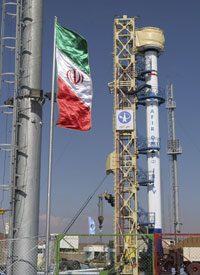
The statement from IRNA said that the satellite, which was named Omid (Farsi for “Hope”) was “successfully set into orbit” aboard a Safir-2 rocket. The agency described the launch as part of a “data-processing satellite project” that began in March 2005 as “the first practical step toward acquiring national space technology.”
“The project’s experts focused on manufacturing the equipment and helping develop the potential of domestic companies to carry out such projects,” said IRNA.
During Iranian state television’s footage of the missile launch, Iran’s President Mahmoud Ahmadinejad was heard in the voiceover: “Dear Iranian nation, your children have placed the first indigenous satellite into orbit. With God’s help and the desire for justice and peace, the official presence of the Islamic Republic was registered in space.”
The launch of the satellite prompted concerns among Western observers who are also diligently monitoring the progress of Iran’s nuclear program, which has prompted sanctions by the UN and the United States. In Paris, the French Foreign Ministry spokesman, Eric Chevallier, said his government was “worried that there is the development of capacities that can be used in the ballistic framework,” the AP reported.
The BBC reported that officials from six world powers — the United States, Russia, China, the UK, France, and Germany — are due to meet in Germany on February 4 to discuss the stand-off between the West and Iran concerning the nation’s nuclear enrichment program.
Andrew Brookes, a spokesman for the International Institute for Strategic Studies (IISS), a think-tank in London, was quoted by Reuters news service as saying that the satellite launch would prompt concern in Israel and elsewhere in the Middle East: “They will think that this civilian capability will soon be transformed to a military reconnaissance and intelligence gathering capability.”
And Isaac Ben-Israel, a former head of the Israel Space Agency, told Reuters reporters in Jerusalem: “If they managed to fire a satellite into space it means they can also reach Western Europe.”
In an article assessing world views to the Iranian satellite launch, the British Guardian newspaper of February 3 quoted Britain’s minister of state for foreign and commonwealth affairs, Bill Rammell, as saying: “There are dual applications for satellite launching technology in Iran’s ballistic missile programme. As a result we think this sends the wrong signal to the international community, which has already passed five successive UN security council resolutions on Iran’s nuclear and ballistic missile programmes.”
But there is likely less to fear from Iran having a missile program than there is to fear from how the news of that program will be "spun" and used by politicians.
One of the more interesting comments about the Iranian satellite launch came from Tal Inbar, the head of the Space Research Center at Israel’s Fisher Brothers Institute. Inbar said on Israel Radio: “We should regard this satellite as the ‘Iranian Sputnik‘. The main value is … propaganda.” Inbar is surely referring to Iranian propaganda efforts, but he could just as easily be referring to propaganda in the United States.
Those who remember (or who have read about) the reaction in the West — particularly the United States — to the launching of the original Sputnik satellite by the Soviet Union in 1957, coming four years after the Soviets announced that they had detonated a hydrogen bomb, know how easy it is to create institutionalized panic through stoking the fears of what may happen.
Under the pretext of improving scientific educational levels in American schools, so that we could “catch up” with the Soviets, direct federal aid to education (which is not authorized in our Constitution) began.
Visions of Soviet missiles raining down nuclear bombs on U.S. cities spawned an inordinate fear of “the bomb” and lent great impetus to the disarmament movement, akin to nothing seen until the more recent fear mongering against “global warming.”
Those who studied Soviet space technology, however, soon concluded that, despite Sputnik, Soviet technology was actually inferior to American. Lloyd Mallan, the author of Russia’s Space Hoax and a aerospace technology expert who would become one of the leading debunkers of Soviet technological claims, went to the USSR in 1958 to study the Soviets’ highly acclaimed advances. He wrote about his experience: “I had been in the Soviet Union for about a month when I learned at Odessa of the Sputnik III launching. I could not believe its weight: by that time I had observed too many aspects, all crude and inferior, of Russian engineering and space-tracking technology.”
Despite the inferiority of Soviet technology, the U.S. media helped build up the Soviet Union in Americans’ eyes as a formidable adversary far in excess of its actual strength. This propaganda worked to the advantage of those who tried to convince Americans that “peace through strength” was no longer a viable strategy, and that “better Red than dead” was a preferable option.
Emboldened by this propaganda victory, on September 25, 1961, President John F. Kennedy presented to the 16th General Assembly of the United Nations a disarmament proposal entitled, Freedom from War: The United States Program for General and Complete Disarmament in a Peaceful World (State Department Publication 7277).
The "disarmament" called for by the document had much more to do with creating a monopoly of force than with weapons elimination. Excerpts from the document include:
• "Disarmament shall take place as rapidly as possible until it is completed in [a program of three] stages containing balanced, phased and safeguarded measures, with each measure and stage to be carried out in an agreed period of time."
• "As states relinquish their arms, the United Nations shall be progressively strengthened in order to improve its capacity to assure international security and the peaceful settlement of differences as well as to facilitate the development of international cooperation in common tasks for the benefit of mankind."
• "By the time Stage II [of the three-stage disarmament program] has been completed, the confidence produced through a verified disarmament program, the acceptance of rules of peaceful international behavior, and the development of strengthened international peace-keeping processes within the framework of the U.N. should have reached a point where the states of the world can move forward to Stage III. In Stage III progressive controlled disarmament and continuously developing principles and procedures of international law would proceed to a point where no state would have the military power to challenge the progressively strengthened U.N. Peace Force and all international disputes would be settled according to the agreed principles of international conduct." (Emphasis added.)
While it is unlikely that Iran will ever be portrayed as quite as potent a military behemoth as the old Soviet Union supposedly was, a little propaganda goes a long way. Consider how those elusive “weapons of mass destruction” were used as a pretext for invading Iraq.
Should President Obama goes on national TV to tell Americans that we must invade Iran to prevent it from being able to launch nuclear-tipped ICBMs at America, you will know the propaganda has achieved its intended objective. Or perhaps Obama will emulate President Kennedy and propose that the United States, Russia, and Iran should turn over all their strategic weapons to the UN!
— Photo: AP Images


